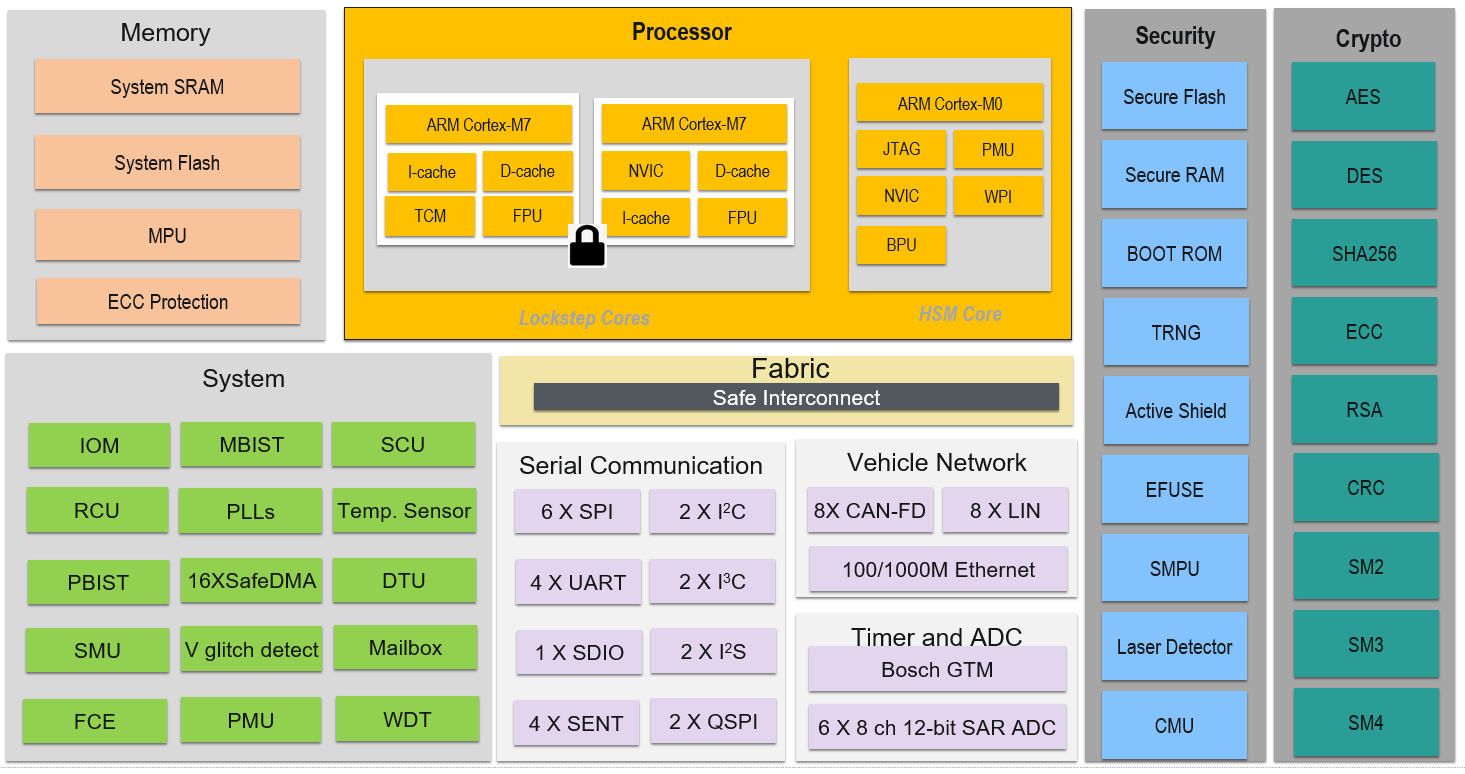|
Model |
RA8L |
RA8 |
|
Core |
Application Core: Cortex-M7; Secure Core: Cortex-M0 |
|
|
Core Qty. |
2 (Lockstep) + 1 |
|
|
Flash |
2MB |
4MB |
|
SRAM |
256KB |
512KB |
|
Secure RAM |
64KB |
64KB |
|
DSP |
Yes |
|
|
FPU |
Double Precision |
|
|
Embedded HSM |
EVITA Full ECC、SHA、SM2/3/4… |
|
|
CAN-FD |
Up to 8 |
Up to 8 |
|
LIN |
4 |
4 |
|
Ethernet |
100M/1000M TSN |
100M/1000M TSN |
|
SPI |
6 |
6 |
|
QSPI |
2 |
2 |
|
UART |
4 |
4 |
|
DMA |
32 |
32 |
|
ADC |
48 |
48 |
|
SENT |
6 |
6 |
|
I2C |
2 |
2 |
RA8 Block Diagram

features
• system
- Power supply: 5V, 3.3V and 1.2V at the same time;
- Application kernel: a set of Cortex-M7 dual-core lockstep, main frequency up to 240MHz, up to 600 Dhrystone MIPS;
- Security kernel: a cortex-M0 kernel, 48MHz;
- Interrupt controller: two sets of NVIC;
- Hardware single increment counter: supports 64-bit system counter
- DMA controller: 32 safe DMA channels;
- Debugging control: the application system supports ARM CoreSight JTAG debugging and Trace debugging; Information security system does not support any debugging, only support internal configuration and call;
- Power mode: support normal operation, low power mode, sleep mode and other power modes;
-Operating temperature: -40-125 °C;
- IO level: supports 5V IO and 3.3V IO.
• memory
- system Flash: up to 4MB ECC;
- System RAM: up to 512KB ECC;
- security Flash: 512KB ECC;
- Secure RAM: 64KB ECC;
- QSPI: a single QSPI supports a maximum of 256 MB external storage.
• communication
- CAN: supports up to 8 channel CAN-FD, compatible with CAN 2.0B;
-LIN: supports a maximum of eight channels.
- Ethernet: 1000 MBIT/s TSN Ethernet supports MII, RMII, and GMII interfaces. 100M Ethernet supports RGMII interface.
- UART: supports a maximum of 4 channels and a baud rate of 5 Mbit/s.
- QSPI: supports a maximum of two groups. Each group supports one input and two outputs. The baud rate is up to 10 Mbit/s.
-spi: supports a maximum of 6 channels and a baud rate of up to 10Mbps.
- SENT: supports a maximum of six routes.
- I2C: supports a maximum of two groups.
- I2S: supports a maximum of two groups.
- SDIO: supports a maximum of 1 group.
- I3C: supports a maximum of 2 groups;
• simulation
- Supports up to 6 sets of 48 12-bit successive approximation adCs;
• the timer
- GTM GEN4.1: 32-bit universal timer, supports up to 32 channel TIM, 32 channel TOM, 64 channel TIO and 24 channel MCS;
- FTM: 16-bit flexible timer, supports up to 8 groups of 64 channels, supports input capture, output comparison and orthogonal codec functions;
The clock,
- FIRC: internal high speed clock frequency 48MHz;
- SIRC: internal low speed clock frequency 32kHz;
- FXOSC: external input clock frequency 40MHz;
• Functional safety
-IO monitor;
-Security DMA;
- Reset control unit;
- Safety management unit;
- Failure control engine;
- Window type watchdog;
- Temperature failure detection;
- Overvoltage and undervoltage detection;
• certification
- ISO 26262 ASIL-D
- OSCCA Certification Grade 2
- EAL4+
- AEC-Q100 Certification Grade1
• packaging
- BGA-180
- LQFP-100
• Information security
- Support high-speed ECDSA (NIST-P256);
- SM2;
- SM3;
- RSA (a maximum of 2048 bits).
ECC - 256;
- SHA - 256;
- AES;
- DES;
- SM4;
